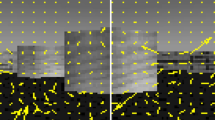Abstract
For visual navigation of an autonomous robot, detection of collision-free direction from an image/ image sequence captured by imaging systems mounted on the robot is a fundamental task. This collision free direction provides the next view to direct attention for computing the next collision free direction. Therefore, the robot requires a cyclic mechanism directing attention to the view and computing the collision free direction from that view. We combine a geometric method for free space detection and a statistical method for visual navigation of the mobile robot. Firstly, we deal with a random-sampling-based method for the detection of free space. Secondly, we deal with a statistical method for the computation of the collision avoiding direction. The robot finds free space using the visual potential defined from a series of views captured by a monocular camera system mounted on the robot to observe the view in front of the robot, We examine the statistical property of the gradient field of the visual potential. We show that the principal component of the gradient of the visual potential field yields the attention direction of the mobile robot for collision avoidance. Some experimental results of navigating the mobile robot in synthetic and real environments are presented.
Preview
Unable to display preview. Download preview PDF.
Similar content being viewed by others
References
Adorini, G., Cagnoni, S., Mordonini, M., Sgorbissa, A.: Omnidirectional stereo systems for robot navigation. In: OMNIVIS (2003)
Barron, J.L., Fleet, D.J., Beauchemin, S.S.: Performance of optical flow techniques. International J. of Computer Vision 12, 43–77 (1994)
Bouguet, J.-Y.: Pyramidal implementation of the Lucas Kanade feature tracker description of the algorithm. Intel Corporation, Microprocessor Research Labs, OpenCV Documents (1999)
Conner, D.C., Rizzi, A.A., Choset, H.: Composition of local potential functions for global robot control and navigation. In: International Conference on Intelligent Robots and Systems, vol. 4, pp. 3546–3551 (2003)
Fischler, M.A., Bolles, R.C.: Random sample consensus: A paradigm for model fitting with applications to image analysis and automated cartography. Comm. of the ACM 24, 381–395 (1981)
Guilherme, N.D., Avinash, C.K.: Vision for mobile robot navigation: A survey. IEEE Trans. on PAMI 24, 237–267 (2002)
Hartley, R., Zisserman, A.: Multiple View Geometry in Computer Vision. Cambridge University Press, Cambridge (2000)
Horn, B.K.P., Schunck, B.G.: Determining optical flow. Artificial Intelligence 17, 185–203 (1981)
Khatib, O.: Real-time obstacle avoidance for manipulators and mobile robots. International J. of Robotics Research 5, 90–98 (1986)
Lucas, B., Kanade, T.: An iterative image registration technique with an application to stereo vision. In: International Joint Conference on Artificial Intelligence, pp. 674–679 (1981)
Mallot, H.A., Bulthoff, H.H., Little, J.J., Bohrer, S.: Inverse perspective mapping simplifies optical flow computation and obstacle detection. Biological Cybernetics 64, 177–185 (1991)
Murray, D., Little, J.: Using real-time stereo vision for mobile robot navigation. Autonomous Robots 8, 161–171 (2000)
Nagel, H.-H., Enkelmann, W.: An investigation of smoothness constraint for the estimation of displacement vector fields from image sequences. IEEE Trans. on PAMI 8, 565–593 (1986)
Ohnishi, N., Imiya, A.: Featureless robot navigation using optical flow. Connection Science 17, 23–46 (2005)
Ohnishi, N., Imiya, A.: Dominant plane detection from optical flow for robot navigation. Pattern Recognition Letters 27, 1009–1021 (2006)
Ohnishi, N., Imiya, A.: Navigation of nonholonomic mobile robot using visual potential field. In: International Conference on Computer Vision Systems (2007)
Ohnishi, N., Imiya, A.: Corridor navigation and obstacle avoidance using visual potential for mobile robot. In: 4th Canadian Conference on Computer and Robot Vision, pp. 131–138 (2007)
Ohnishi, N., Imiya, A.: Independent component analysis of layer optical flow and its application. In: 2nd International Symposium on Brain, Vision and Artificial Intelligence, pp. 171–180 (2007)
Ohnishi, N., Imiya, A.: Independent component analysis of optical flow for robot navigation. Neurocomputing 71, 2140–2163 (2008) (accepted for publication)
Park, K.-Y., Jabri, M., Lee, S.-Y., Sejnowski, T.J.: Independent components of optical flows have MSTd-like receptive fields. In: Proc. of the 2nd International Workshop on ICA and Blind Signal Separation, pp. 597–601 (2000)
Santos-Victor, J., Sandini, G.: Uncalibrated obstacle detection using normal flow. Machine Vision and Applications 9, 130–137 (1996)
Tews, A.D., Sukhatme, G.S., Matarić, M.J.: A multi-robot approach to stealthy navigation in the presence of an observer. In: ICRA, pp. 2379–2385 (2004)
Trihatmo, S., Jarvis, R.A.: Short-safe compromise path for mobile robot navigation in a dynamic unknown environment. In: Australian Conference on Robotics and Automation (2003)
Vaina, L.M., Beardsley, S.A., Rushton, S.K.: Optic flow and beyond. Kluwer Academic Publishers, Dordrecht (2004)
Wong, B., Spetsakis, M.: Scene reconstruction and robot navigation using dynamic fields. Autonomous Robots 8, 71–86 (2000)
Zemel, R.S., Sejnowski, T.J.: A model for encoding multiple object motions and self-motion in area mst of primate visual cortex. Neuroscience 18, 531–547 (1998)
Author information
Authors and Affiliations
Editor information
Editors and Affiliations
Rights and permissions
Copyright information
© 2009 Springer-Verlag Berlin Heidelberg
About this paper
Cite this paper
Ohnishi, N., Imiya, A. (2009). Combination of Geometrical and Statistical Methods for Visual Navigation of Autonomous Robots. In: Cremers, D., Rosenhahn, B., Yuille, A.L., Schmidt, F.R. (eds) Statistical and Geometrical Approaches to Visual Motion Analysis. Lecture Notes in Computer Science, vol 5604. Springer, Berlin, Heidelberg. https://doi.org/10.1007/978-3-642-03061-1_11
Download citation
DOI: https://doi.org/10.1007/978-3-642-03061-1_11
Publisher Name: Springer, Berlin, Heidelberg
Print ISBN: 978-3-642-03060-4
Online ISBN: 978-3-642-03061-1
eBook Packages: Computer ScienceComputer Science (R0)




